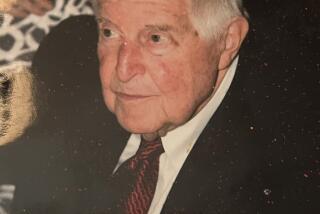Margot Feuer dies at 89; helped create Santa Monica Mountains park
After Margot Feuer moved to the hills of Malibu in 1965, she was “catapulted into community action” by the threat of development in the surrounding Santa Monica Mountains. The terrifying proposals included building a nuclear power plant in an isolated canyon and a freeway through Malibu Canyon.
“I looked around at what I was in the middle of,” she later said, “and I figured, gosh, the idea of a park is a beautiful idea.”
Hundreds would join her in the movement to create a national park in Los Angeles, but only Feuer and two other activists would be recognized as “the founding mothers” of the Santa Monica Mountains National Recreation Area, which won federal approval in 1978.
Feuer, the last survivor of the trio of advocates, died June 16 of a stroke at her Los Angeles home overlooking Stone Canyon in the Santa Monica Mountains, said her son Mark. She was 89.
“We are indebted to Margot for her lifelong environmental activism and the important role she played in establishing the nation’s largest urban national park,” Lorenza Fong, acting superintendent of the recreation area, said in a statement to The Times.
Feuer’s sisters in activism were Jill Swift, who built grass-roots awareness by organizing hikes in the Santa Monica Mountains, and Susan Nelson, who worked closely with then-Reps. Phillip Burton (D-San Francisco) and Anthony C. Beilenson (D-Woodland Hills).
When the Sierra Club noticed Feuer speaking up at county meetings, she was asked to join Swift as co-chair of the group’s Santa Monica Mountains Task Force.
Feuer became the Sierra Club’s principal lobbyist for the park and made repeated trips to Washington to testify before Congress, according to the 2006 edition of “National Parks and the Woman’s Voice: A History.”
“A few citizens like Margot made it happen. It’s not anything that one agency did,” said David Brown, conservation chairman of the Santa Monica Mountains Task Force. “She persisted, she had connections that helped and she cared deeply.”
On the Westside in 1978, a group of park supporters were nervously awaiting the results of a congressional vote when a phone rang. Feuer went to answer it and returned to announce that legislation establishing the recreation area had passed. The park has since grown to encompass more than 150,000 acres.
Feuer regarded the creation of the park as a major achievement — and a reaffirmation of the democratic process.
“The public is so often chastised for not really hanging in” to achieve action on a particular cause, she told The Times in 1978. “This reaffirms the need for really hanging in. All those people who worked — for that length of time — did it.”
A portion of that quote is on a plaque at the recreation area’s recently opened visitors center at the historic King Gillette Ranch, a parcel of land in Calabasas that Feuer helped rescue from development.
Margot Elizabeth Kramer was born in 1922 and grew up in New Haven, Conn., the younger of two daughters of Morris and Eva Kramer, immigrants from Russia. Her father gave up farming in South Dakota to become a furrier.
Growing up, she developed an appreciation for nature while hiking the trails of Long Island, her son said.
At Wellesley College, she earned a bachelor’s degree in music in 1943 before moving to New York to try to make it in the theater.
In 1946, she moved to Los Angeles to further her singing career. She soon met and married Stanley Feuer, who was a mechanical engineer.
As a local environmental activist, Margot Feuer started out as a founder of Stamp Out Smog, which was formed by women who were “self-described amateurs in politics but willing to learn,” The Times reported in 1959.
Since the mid-1960s, she had been involved with county government on land-use planning issues and had served on the South Coast Regional Commission of the California Coastal Commission.
As a founder and leader of Save Open Space Santa Monica Mountains, Feuer played a major role in helping to preserve the Ahmanson Ranch on the eastern edge of Ventura County and the neighboring Jordan Ranch, according to Joanne Jackson, a longtime friend.
In addition to her son Mark of Boulder, Colo., Feuer is survived by two other sons, Zachary Feuer of Los Angeles and Dr. Joshua Feuer of Santa Barbara; and four grandchildren. Her husband died at 74 in 1989.
She had long argued for the importance of a centrally located visitors center in the recreation area, once testifying before a planning commission that “there’s no there there, meaning there’s no destination, just a bunch of scattered parks,” Brown said.
About a week before the visitors center officially opened on June 9, Feuer paid a visit and inspected a concrete tube “in her inimitable style,” Jackson recalled. “Margot got down on her 89-year-old knees and insisted on experiencing what a wild coyote does when crawling through the pipe — so typical of her always curious mind.”
More to Read
Start your day right
Sign up for Essential California for the L.A. Times biggest news, features and recommendations in your inbox six days a week.
You may occasionally receive promotional content from the Los Angeles Times.







